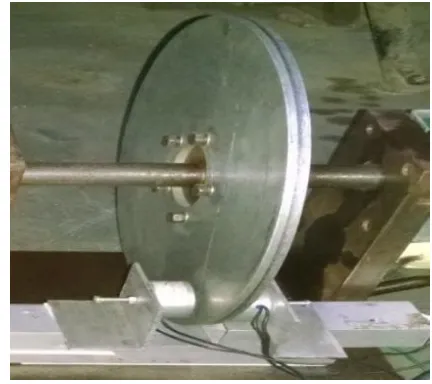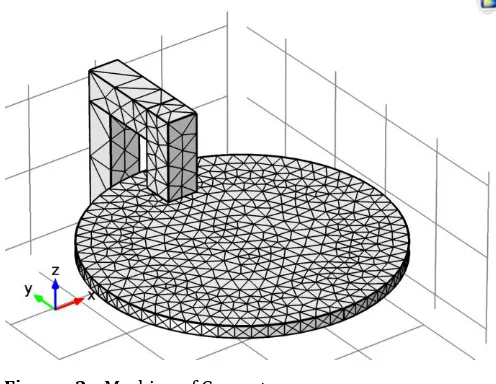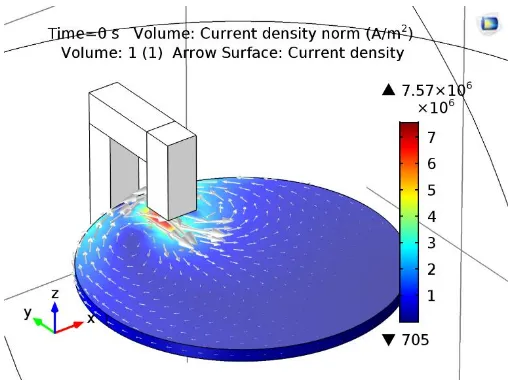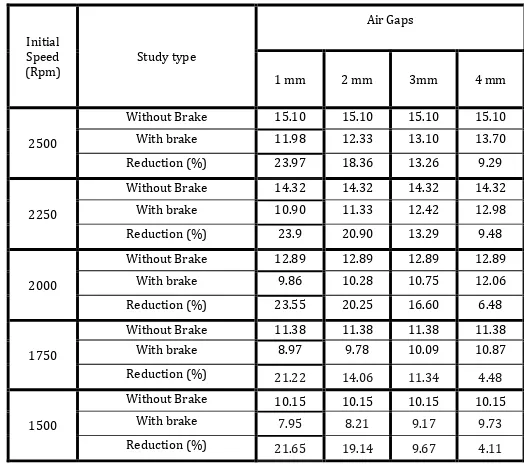Volume: 03 Issue: 04 | Apr-2016 www.irjet.net p-ISSN: 2395-0072
© 2016, IRJET ISO 9001:2008 Certified Journal Page 809
Design & Fabrication of Eddy Current Braking System
Oscar Rodrigues
1, Omkar Taskar
1, Shrutika Sawardekar
1Henderson Clemente
1, Girish Dalvi
21
Students of Department of Mechanical Engineering, FCRIT, Vashi, Navi Mumbai
2
Assistant Professor, Department of Mechanical Engineering, FCRIT, Vashi, Navi Mumbai, Maharashtra, India
---***---
Abstract
-Majority of braking systems work on theprinciple of dissipation of kinetic energy to heat energy. This method has its own drawbacks and must be replaced with a more reliable braking system that is quick in response, doesn’t heat up and is maintenance free. In this project the design an eddy current braking system and optimization for various operational parameters has been done. These parameters have been previously iterated in cited projects and papers and also in the simulation models and are to be cross-checked with the experimental setup.
Keywords – Brakes, COMSOL Multiphysics, Eddy Current, Electromagnet, Parametric Sweep
1.
INTRODUCTION
In the operation of any machinery the most primary safety system is the braking system. The most basic designs of the braking system involve the conversion of kinetic energy to heat energy by friction. This is accomplished by friction between two rubbing surfaces. These brakes pose several problems i.e. significant wear, fading, complex and slow actuation, lack of fail-safe features, increased fuel consumption due to power assistance, and requirement for anti-lock controls. To solve these problems, a contactless magnetic brake has been developed. This concept includes a metals disk which will conduct eddy currents generated by magnets.
This brake is wear-free, less-sensitive to temperature than friction brakes, has fast and simple actuation, and has a reduced sensitivity to wheel lock. This is achieved by the generation of braking torque by a magnetic field across a moving conductor which creates a perpendicular magnetic field by induced eddy currents. Contactless brakes can be applied to any machinery like automobiles, locomotives, roller coasters, hydraulic and turbo machinery, machine tools, elevators, etc. The wide range applicability of these brakes strongly imply the effectiveness and ease of operation. The braking force can be adjusted to control higher torque loads by varying the coil turns or by increasing the voltage. This gives flexibility of operation of
the system and makes it reliable even in changing loading patterns. A study of eddy current braking system is performed to find out the practical limit of using an electromagnetic braking system.
2.
METHODOLOGY
Modelling of designed experimental setup is done in Autodesk Inventor and simulation analysis is done in COMSOL Multiphysics software. By Schieber’s equation, it can be said that with increase in air gap and disc thickness, the torque generated by the electromagnets is decreased. This relation can be verified by noting the stoppage time after varying the air gap. As per the model the stoppage time must reduce with increase in air gap.
Following parameters are selected after literature survey
2.1
Rotor Disc
[image:1.612.340.556.469.661.2]Experiments done by G. Priyandokoshows that Aluminum 6061 is the best material to be used as rotating element in eddy current braking [10] [16].
Figure -1: Rotor Disc
© 2016, IRJET ISO 9001:2008 Certified Journal Page 810
2.2
Electromagnets
Electromagnets are DC type that can be powered by battery. Electromagnets are selected instead of permanent magnet as electrical actuation is faster than mechanical actuation with lower losses
2.3
Schieber’s Model
Schieber’s model is selected for verifying experimental results with theoretical [2]. The model gives fairly accurate results over low as well as high speed range. According to Schieber’s equation, the braking toque generated in rotating disc under the influence of electromagnetic field is given by,
Where,
= electrical conductivity of the rotating disk = sheet thickness rotating disk
= initial angular velocity r = radius of electromagnet
m = distance of disc axis from pole-face center BZ = Magnetic flux density
a = disk radius
3.
SIMULATION
The simulation was carried out on COMSOL Multiphysics® on magnetic and electric fields module. The aim of the simulation was to verify the actual results and to generate the deceleration plot. The deceleration plot shows an early drop in velocity due to high torque developed by eddy current present in the disc.
The initial parameters were loaded in the study. A stationary study was done to evaluate the eddy current generated in the disc. Also a time dependent study was done to show the development of the same eddy currents in the disc with deceleration.
3.1
Meshing
[image:2.612.322.570.198.390.2]The meshing must be more concentrated in the junction were the magnetic field lines transferred into the disc from the magnet. The mesh shape was selected to be free tetrahedral and triangular edge elements. [18]
Figure -2: Meshing of Geometry
The junction had been meshed to an average element size of 0.9mm whereas the rest of the geometry was meshed up to 24mm mesh size.
3.2
Parametric Sweep
To understand the behaviour of the ECB under varying conditions varying a parameter had to be done. The initial speed and airgaps were physically possible to vary and hence the simulation was done by varying the initial disc speed and the airgap
Volume: 03 Issue: 04 | Apr-2016 www.irjet.net p-ISSN: 2395-0072
© 2016, IRJET ISO 9001:2008 Certified Journal Page 811 Chart -1:Deceleration graphs for 1mm air gap
Chart -2:Deceleration graphs for 2mm air gap
Chart -3:Deceleration graphs for 3mm air gap
Chart -4:Deceleration graphs for 4mm air gap
© 2016, IRJET ISO 9001:2008 Certified Journal Page 812 Table 1 shows the braking time obtained by theoretical
calculation and by simulation and the observed percentage deviation.
Table -1:Theoretical and Simulated Braking Time
Initial Speed
(Rpm) Study type
Air Gaps
1
mm 2 mm 3mm 4 mm
2500
Theoretical 14.57 15.89 16.23 16.59
Simulation 13.3 14.7 15.2 16.9
Deviation (%) 8.71 7.48 6.34 1.86
2250
Theoretical 13.29 14.38 14.65 14.95
Simulation 12.1 13.1 13.7 15.8
Deviation (%) 8.95 8.90 6.48 5.68
2000
Theoretical 11.97 12.85 13.07 13.3
Simulation 10.2 11.5 12.2 13.9
Deviation (%) 14.78 10.50 6.65 4.5113
1750
Theoretical 10.62 11.3 11.47 11.65
Simulation 9.2 9.9 11.7 12.9
Deviation (%) 13.37 12.34 2.00 10.73
1500
Theoretical 9.23 9.74 9.87 10
Simulation 8.2 8.8 10.1 12
Deviation (%) 11.15 9.65 2.33 20
3.3
Results and conclusion
[image:4.612.325.599.347.520.2]The deceleration plot was extracted and studied under the experimentation phase. A close resemblance was found between the deceleration plot from the experiment and the simulation. Speeds drops for all parameter setting were found and compared.
Figure -3: Eddy Current density plot
There was a little difference between simulated and actual graphs which can be accounted for bearing and air friction of the disc and the shaft. Therefore, it is found the after 4mm
airgap there is very little effect of the electromagnets on the disc which reduces braking effectiveness. Also, the established design procedure for ECB design performs as per the simulated data.
4.
Experimentation
The experimental setup is designed and fabricated in such a way that it resembles to a high speed application such as turbines, high speed spindle rotation etc. The motor here denotes a high speed application. 2 12V batteries are arranged in series to get 24V DC supply. Table 1 shows the theoretical braking time obtained using Schieber’s equation, following values of braking time is obtained.
Figure 4 shows CAD model of experimental
setup
[image:4.612.34.289.446.636.2]Volume: 03 Issue: 04 | Apr-2016 www.irjet.net p-ISSN: 2395-0072
[image:5.612.317.579.118.350.2]© 2016, IRJET ISO 9001:2008 Certified Journal Page 813 Figure 5 shows the fabricated experimental setup.
Figure -5: Experimental Setup
Experiments are performed on setup at speed of 2500, 2250, 2000, 1750 and 1500 rpm taking 1 mm, 2mm, 3mm air gap for each speed.
[image:5.612.37.311.130.304.2]Based on experiments, the following graph is extrapolated as shown in figure6.
[image:5.612.36.288.407.532.2]Figure -6: Deceleration plot for 1mm airgap at 2500rpm with and without braking superimposed on each other
Table 2 shows the results of braking time obtained similarly for various speeds and air gap settings and their relative difference in percentage.
Table -2:Experimental Braking Time
Initial Speed
(Rpm) Study type
Air Gaps
1 mm 2 mm 3mm 4 mm
2500
Without Brake 15.10 15.10 15.10 15.10
With brake 11.98 12.33 13.10 13.70
Reduction (%) 23.97 18.36 13.26 9.29
2250
Without Brake 14.32 14.32 14.32 14.32
With brake 10.90 11.33 12.42 12.98
Reduction (%) 23.9 20.90 13.29 9.48
2000
Without Brake 12.89 12.89 12.89 12.89
With brake 9.86 10.28 10.75 12.06
Reduction (%) 23.55 20.25 16.60 6.48
1750
Without Brake 11.38 11.38 11.38 11.38
With brake 8.97 9.78 10.09 10.87
Reduction (%) 21.22 14.06 11.34 4.48
1500
Without Brake 10.15 10.15 10.15 10.15
With brake 7.95 8.21 9.17 9.73
Reduction (%) 21.65 19.14 9.67 4.11
Chart 5, 6, 7 and 8 shows the comparison of braking time without braking system and with braking system with air gap of 1mm, 2mm, 3mm and 4mm respectively.
Chart -5:Braking Time with 1 mm Air Gap
[image:5.612.323.579.416.589.2]© 2016, IRJET ISO 9001:2008 Certified Journal Page 814 Chart -6:Braking Time with 2 mm Air Gap
Chart -7:Braking Time with 3 mm Air Gap
Chart -8:Braking Time with 4 mm Air Gap
5.
CONCLUSION AND FUTURE WORK
The purpose of the study was to perform a comparative study of theoretical and practical braking time and establish a practical air gap limit beyond which the electromagnetic brakes loses their effectiveness. From theoretical calculations and experimented braking time values, a maximum reduction in braking time 23.97% is found and max air gap limit of 3 mm is obtained beyond with electromagnetic brakes are found to be ineffective.
Further, a magnet of higher magnetic flux density can be used to minimize the braking time. Also, magnets can be positioned at different locations around the disc in radial arrangement to get better braking torque distribution.
6.
REFERENCES
[1]. Max Baermann, (1970) “Permanent Magnet Eddy Current Brake or Clutch”, USPO3, 488,535
[2]. P. Hanyecz, (1982), “Calculation of Braking force in Eddy current brakes”, Department of Theoretical Electricity. Technical University Budapest
[3]. Pushkin Kachroo, (1997), “Modelling and control of Electromagnetic brakes”, Faculty Publications, University of Nevada, Las Vegas
[4]. Tohuru Kuwahara, (1999), “Permanent type eddy current braking system”, USPO5944149
[5]. Marc T. Thompson, “Permanent Magnet
Volume: 03 Issue: 04 | Apr-2016 www.irjet.net p-ISSN: 2395-0072
© 2016, IRJET ISO 9001:2008 Certified Journal Page 815 [6]. Kyi Wan Park; Kap J in Lee, (2001), “Contactless eddy
current brake for cars”, USPO6286637
[7]. Marc T. Thompson, Edward Pribonic, (2003),” Eddy current braking apparatus”, USPO6533083
[8]. Min Jou, Jaw-Kuen Shiau, Chi-Chian Sun, (2006), Design of magnetic braking system”, Journal of Magnetism and Magnetic Materials-Sep 2006. [9]. Der-Ming Ma, Jaw-Kuen Shiau, (2010), “Design of
eddy-current magnet brakes”, Department of Aerospace Engineering, Tamkang University, Danshuei, Taiwan.
[10]. G. Priyandoko, M.Z. Baharom, (2011), “Eddy Current Braking Study for Brake Disc of aluminium, Copper and Zink, Regional Engineering Postgraduate Conference (EPC) 2011
[11]. Yuichi Tashiro, Tokyo, Mitsuyoshi Oba, (2011), “Electromagnetic Type Retarder”, United States Patent Application Publication US 2011/0214954 A1. [12]. G. Priyandoko, M.Z. Baharom, (2013), ‘Parameter
Analysis of Electromagnetic Braking Using Fully Nested and Two Way ANOVA”, Article · January 2013 DOI: 10.4028/www.scientific.net/AMM.663.193 [13]. Ren He, Xuejun Liu, and Cunxiang Liu, (2013), “Brake
Performance Analysis of ABS for Eddy Current and Electrohydraulic Hybrid Brake System”, Hindawi Publishing Corporation, Mathematical Problems in Engineering Volume 2013, Article ID 979384, 11 pages http://dx.doi.org/10.1155/2013/979384
[14]. Peter Mongeau, (2014), “Wind Turbine Generator Having an Eddy Current Brake, Wind Turbine Having Such a Generator, And Associated Methods” United States Patent Application Publication
US2014/0110947 A1
[15]. Gigih Priyandoko, M.Z Baharom, (2015), “Air-gap effect on Single Axis Vibration of Electromagnetic Braking Using Eddy Current on Bearing cage”,
Advanced Structural Integrity and Vibration Research Group (ASIVR), Faculty of Mechanical Engineering, University Kebangsaan Malaysia, Published on ResearchGate
http://www.researchgate.net/publication/27305812 1
[16]. Gigih Priyandoko, M.Z Baharom, (2015), “Eddy current braking experiment using brake disc from aluminium series of A16061 and A17075”
[17]. Deshmukh M.S.*1, Bhamre V.G., (2015), “Frictionless Braking System for Wind Turbine”, International Journal of Engineering, Education and Technology (ARDIJEET) www.ardigitech.in ISSN 2320-883X, VOLUME 3, ISSUE 2, 01/04/2015



